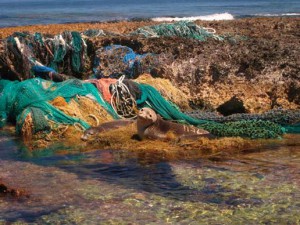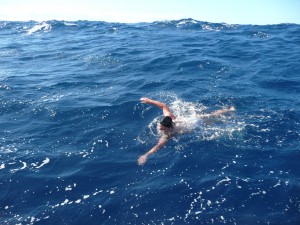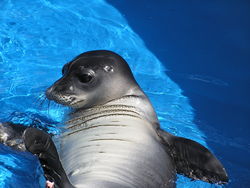U.S. Fish & Wildlife Service, Papahānaumokuākea Marine National Monument
The August 2010 monthly update provides the following information on Hawaiian monk seals from the FWS Papahānaumokuākea team:

“Hawaiian Islands NWR – French Frigate Shoals/ Tern Island […] Staff conducted marine debris pickups throughout the month. On one day alone, a full pallet tub of debris, nets, rope, wire, and trash was removed from East Island. Removal of netting, ropes, and wire is especially important to prevent Hawaiian monk seals and green turtles from potentially becoming entangled. […]
The French Frigate Shoals updates regarding Hawaiian monk seal activities are: 36 monk seal pups have been born; 5 are still nursing; 21 have weaned (of which 3 were killed by sharks); 1 pup died before it was weaned; and 6 pups have disappeared. Two weaned pups with nonfatal shark bites were frequenting East Island. […]


 On Saturday, September 4, 2010, team “Hawaiian Monk Seal” from
On Saturday, September 4, 2010, team “Hawaiian Monk Seal” from 
 The NOAA Ship Oscar Elton Sette is at sea for 19 days on a scientific expedition to support Pacific Islands Fisheries Science Center (PIFSC) staff studying monk seals in the remote Northwestern Hawaiian Islands (NWHI).
The NOAA Ship Oscar Elton Sette is at sea for 19 days on a scientific expedition to support Pacific Islands Fisheries Science Center (PIFSC) staff studying monk seals in the remote Northwestern Hawaiian Islands (NWHI). Jeff Walters is the Hawaiian monk seal recovery coordinator for NOAA Fisheries Service. Walters said that in the isolated northwest Hawaiian islands, the number of monk seals is declining by four percent every year. That’s the bad news. But the good news is that a smaller population of seals on the main Hawaiian islands is growing and thriving, he said.
Jeff Walters is the Hawaiian monk seal recovery coordinator for NOAA Fisheries Service. Walters said that in the isolated northwest Hawaiian islands, the number of monk seals is declining by four percent every year. That’s the bad news. But the good news is that a smaller population of seals on the main Hawaiian islands is growing and thriving, he said.